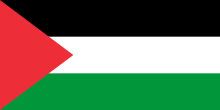Urang Palestina
Tampilan
Urang Palestina (bahaso Arab: الفلسطينيون, translit. al-Filasṭīniyyūn) atau Urang Arab Palestina adolah suku bangso Arab nan barasa dari nagari Palestina di Asio Baraik Dayo. Urang Palestina adolah urang nan manjunjuang budayo Arab dan babahaso Arab.
Etimologi
[suntiang | suntiang sumber]Namo "Palestina" nan dalam bahaso Arab disabuik Filasṭīn (فلسطين) diambil daripado bahaso Yunani, Palaistínē (Παλαιστίνη), marujuak ka nagari pasisia Fenesio dakek nagari Masir dan Yordanio di sabalah utaro Samananjuang Arab.
Rujuakan
[suntiang | suntiang sumber]- ↑ a b c d ’Palestinian Central Bureau of Statistics (PCBS) Presents the Conditions of Palestinian Populations on the Occasion of the International Population Day, 11/07/2022,’ Palestinian Central Bureau of Statistics (PCBS) 7 July 2022
- ↑ a b c d e "Where We Work UNRWA". UNRWA.
- ↑ a b 'PCBS reports Palestinian population growth to 4.81 million,' Archived 13 July 2016 di Wayback Machine. Ma'an News Agency 11 July 2016.
- ↑ 'The World Fact Book CIA July 2015.
- ↑ 'PCBS: The Palestinians at the end of 2015,' Archived 2023-05-03 di Wayback Machine. 30 December 2015
- ↑ "Palestinian Central Bureau of Statistics (PCBS) Press Release" (PDF). Diarsipkan dari versi asli (PDF) tanggal 2017-10-10. Diakses tanggal 2023-10-17.
- ↑ ‘Israel’s population approaches 9.7 million as 2022 comes to an end,’ Times of Israel 10 December 2022
- ↑ Kutipan rusak: Tag
<ref>indak sah; indak ado teks untuak ref banamolaventana1 - ↑ a b c d e f g h "The Arab, Palestinian people group is reported in 25 countries". Joshua Project. Diakses tanggal 26 June 2016.
- ↑ "U.S. Census website". United States Census Bureau. Diakses tanggal 22 April 2009.
- ↑ "Palestinians Living in UAE Uncertain Over Peace Deal With Israel". The Media Line. 16 August 2020.
- ↑ "Lebanon conducts first-ever census of Palestinian refugees". 21 December 2017.
- ↑ Jorge Alberto Amaya, Los Árabes y Palestinas en Honduras: su establecimiento e impacto en la sociedad hondureña contemporánea:1900–2009 Archived 18 August 2016 di Wayback Machine. 23 July 2015.'En suma, los árabes y Palestinas, arribados al país a finales del siglo XIX, dominan hoy en día la economía del país, y cada vez están emergiendo como actores importantes de la clase política hondureña y forman, después de Chile, la mayor concentración de descendientes de Palestinas en América Latina, con entre 150,000 y 200,000 personas.'
- ↑ "Inside Berlin's famous Palestinian neighbourhood". Middle East Eye.
- ↑ "Palestinians Open Kuwaiti Embassy". Al Monitor. 23 May 2013. Diarsipkan dari versi asli tanggal 22 May 2013. Diakses tanggal 23 May 2013.
- ↑ "El Salvador's Palestinian connection". 26 February 2006.
- ↑ "test0.com". Diarsipkan dari versi asli tanggal 23 March 2009.
- ↑ "Factsheet: Palestinian Refugees in Iraq". Diarsipkan dari versi asli tanggal 20 July 2009. Diakses tanggal 16 June 2009.
- ↑ "Ethnic Origin (247), Single and Multiple Ethnic Origin Responses (3) and Sex (3) for the Population of Canada, Provinces, Territories, Census Metropolitan Areas and Census Agg." 2.statcan.ca. Diarsipkan dari versi asli tanggal 12 July 2020. Diakses tanggal 22 April 2009.
- ↑ "The Palestinian Diaspora in Europe". Diarsipkan dari versi asli tanggal 24 August 2013. Diakses tanggal 22 June 2011.
- ↑ "Did you know that ... Palestinians in the Netherlands – Palestine Link". Diarsipkan dari versi asli tanggal 4 November 2018. Diakses tanggal 4 November 2018.
- ↑ "Handing on the key" (PDF). Diarsipkan dari versi asli (PDF) tanggal 2 November 2012. Diakses tanggal 21 May 2011.
- ↑ "Australians' Ancestries" (PDF).
- ↑ Miguel Benito. "Palestinier". Diarsipkan dari versi asli tanggal 29 July 2013.
- ↑ "2013 UNHCR country operations profile – Algeria". United Nations High Commissioner for Refugees. 2013. Diakses tanggal 22 December 2013.
- ↑ Mor, M., Reiterer, F. V., & Winkler, W. (2010). Samaritans: Past and present: Current studies. Berlin: De Gruyter. p. 217.
- ↑ Miller, Elhanan (26 April 2013). "Clinging to ancient traditions, the last Samaritans keep the faith". The Times of Israel. Diakses tanggal 16 February 2016.
- ↑ Chapter 1: Religious Affiliation retrieved 4 September 2013
- ↑ Hajjej, Abdelhafidh; Almawi, Wassim Y.; Arnaiz-Villena, Antonio; Hattab, Lasmar; Hmida, Slama (9 March 2018). "The genetic heterogeneity of Arab populations as inferred from HLA genes". PLOS ONE (dalam bahasa Inggris). 13 (3): e0192269. doi:10.1371/journal.pone.0192269
 . ISSN 1932-6203. PMC 5844529
. ISSN 1932-6203. PMC 5844529  . PMID 29522542.
. PMID 29522542.

